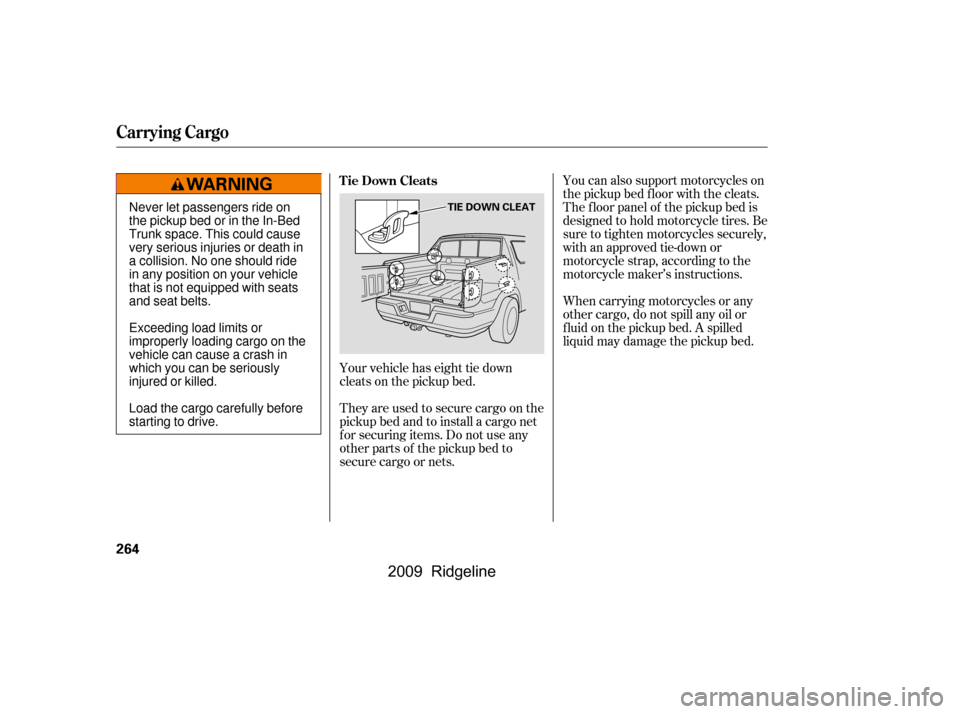Page 266 of 427

Store or secure all items that could
be thrown around and hurt
someone during a crash.Distribute cargo evenly on the
f loor in the In-Bed Trunk, placing
the heaviest items on the bottom
and as far forward as possible. Tie
down items that could be thrown
during a crash or sudden stop.
Make sure the In-Bed Trunk lid is
closed securely bef ore driving.
Be sure the total weight of the
items in the In-Bed Trunk does not
exceed 300 lbs (136 kg).
If you use an accessory roof rack,
the roof rack weight limit may be
lower. Ref er to the inf ormation that
came with your roof rack.
Be sure items placed on the f loor
behind the f ront seats cannot roll
underneath and interf ere with the
proper operation of the seats, the
sensors under the seats, or the
driver’s ability to operate the
pedals.
Keep the glove box closed while
driving. If it is open, a passenger
could injure their knees during a
crash or sudden stop.
If youfoldtherearseatsup,tie
down items that could be thrown
about the vehicle during a crash or
sudden stop. Also, keep all cargo
below the bottom of the windows.
If it is higher, it could interf ere
with the proper operation of the
side curtain airbags.
Distribute cargo evenly on the
floor of the cargo area with the
rear seats f olded up, placing the
heaviest items on the bottom and
as far forward as possible. Tie
down items that could be thrown
about the vehicle during a crash or
sudden stop.
If you carry any items on a roof
rack,besurethetotalweightof
the rack and the items does not
exceed 110 lbs (50 kg).
Carrying Items in the Passenger
Compartment
Carrying Cargo in the In-Bed
T runk or on a Roof Rack
Carrying Cargo
262
�\f���—�\f���—�\f���y���\f��
��������y���
�(���������\f�y�\f�������y
2009 Ridgeline
Page 267 of 427

Your vehicle can carry a large
amount of cargo in the pickup bed.
However, the pickup bed is not
intended f or carrying passengers.
Peoplewhorideinthepickupbed
can be very seriously injured or
killed in a crash (see page ).
Make sure your cargo is properly
loaded and all items are secured so
they will not shif t or f all out while
driving.
When loading and unloading cargo,
make sure all passengers or any
objects are clear of the tailgate
bef ore opening or closing it. The
tailgate should be closed securely
bef ore driving when it is not used
as the extended pickup bed.
The maximum allowable loading
weight on the pickup bed is 1,100
lbs (500 kg). Do not exceed the
load limit (see page ).
Distribute cargo evenly on the
pickup bed. Place the heaviest
items on the bottom and as f ar
f orward as possible of the rear
axle. Tie down and secure all
items that could be thrown out of
the vehicle during a crash or
sudden stop.
If you stack items higher than the
bed sides, tailgate, or back window,
secure them with a net or cover.
This will reduce the risk of items
beingthrownoutof thepickup
bed during a crash or sudden stop.
When the tailgate is dropped open,
itcanbeusedasanextended
pickup bed. The maximum
allowable weight on the tailgate
while driving is 300 lbs (136 kg).
Exceeding this limit could damage
the tailgate.
Carrying heavy cargo in the
pickup bed will raise your vehicle’s
center of gravity. This can affect
handling and perf ormance. Drive
more slowly and cautiously, and
allow extra time and distance f or
braking.
8
260
CONT INUED
Carrying Cargo in the Pickup Bed
Carrying Cargo
Bef ore Driving
263
Allowing passengers to ride in
the pickup bed or on the tailgate
can result in death or serious
injury in a crash.
Make sure all passengers ride
in a seat and wear a seat belt
properly.
�����—�����—�����y���������������y���
�(�����������y���������y
2009 Ridgeline
Page 268 of 427

You can also support motorcycles on
the pickup bed floor with the cleats.
The f loor panel of the pickup bed is
designed to hold motorcycle tires. Be
sure to tighten motorcycles securely,
with an approved tie-down or
motorcycle strap, according to the
motorcycle maker’s instructions.
They are used to secure cargo on the
pickup bed and to install a cargo net
f or securing items. Do not use any
other parts of the pickup bed to
secure cargo or nets.
When carrying motorcycles or any
other cargo, do not spill any oil or
f luid on the pickup bed. A spilled
liquid may damage the pickup bed.
Your vehicle has eight tie down
cleats on the pickup bed.
Tie Down Cleats
Carrying Cargo
264
TIE DOWN CLEATNever let passengers ride on
the pickup bed or in the In-Bed
Trunk space. This could cause
very serious injuries or death in
a collision. No one should ride
in any position on your vehicle
that is not equipped with seats
and seat belts.
Exceeding load limits or
improperly loading cargo on the
vehicle can cause a crash in
which you can be seriously
injured or killed.
Load the cargo carefully before
starting to drive.
�����—�����—�����y�����������
���y���
�(�����������y���������y
2009 Ridgeline
Page 269 of 427
The cargo net can be used to hold
lightweight items in the pickup bed.
Secure all items properly. The net
may not prevent heavy items f rom
beingthrownoutwardinacrashora
sudden stop.The cargo cover can be used to
cover the cargo area on the pickup
bed.
Your vehicle’s pickup bed has a rust
resistant surf ace. To repair small
chips and scratches in the bed, a
repair kit is available f rom your
dealer. More extensive damage
should be repaired by your dealer.
To avoid problems with the bed
surf ace and the In-Bed Trunk lid, do
not use spray-in bed liner products.
Optional Cargo Net
Optional Cargo Cover
Pickup Bed Repair
Carrying Cargo
Bef ore Driving
265
�\f���—�\f���—�\f���y���\f����\f��
���y���
�(���������\f�y�\f�����\f�y
2009 Ridgeline
Page 272 of 427

Your vehicle has higher ground
clearance that allows you to travel
over bumps, obstacles, and rough
terrain. It also provides good
visibility so you can anticipate
problems earlier.With heavy cargo on the pickup bed,
your vehicle has a higher center of
gravity. Drive slowly and cautiously,
and allow more time and distance f or
braking. Loading heavy cargo could
af f ect your vehicle’s handling and
perf ormance.
To prevent rollovers or loss of
control:
Take corners at slower speeds
than you would with a passenger
vehicle.
Avoid sharp turns and abrupt
maneuvers whenever possible.
Make sure the cargo is properly
loaded and all items are secured so
they will not shif t while driving.
Do not modif y your vehicle in any
way that would raise the center of
gravity.
Do not carry heavy cargo on the
roof .
Your vehicle allows you to carry
more cargo than a typical passenger
vehicle.
Because your vehicle rides higher
of f the ground, it has a high center
of gravity that can cause it to roll
over if you make abrupt turns. Utility
vehicles have a signif icantly higher
roll over rate than other types of
vehicles.
See page f or of f -highway driving
guidelines. 306
Driving Guidelines
268
�����—�����—�����y���������������y���
�(�����������y���������y
2009 Ridgeline
Page 273 of 427

Youshoulddothefollowingchecks
and adjustments bef ore you drive
your vehicle.Make sure all windows, mirrors,
and outside lights are clean and
unobstructed. Remove f rost, snow,
or ice.
Check that the hood is f ully closed.
Check that the tailgate is f ully
closed when it is not used as an
extended pickup bed.
Visually check the tires. If a tire
looks low, use a gauge to check its
pressure.
Check that any items you may be
carrying are stored properly or
f astened down securely. Check the adjustment of the
inside and outside mirrors (see
page ).
Check the steering wheel
adjustment (see page ).
Make sure the doors and In-Bed
Trunk are securely closed and
locked.
Fasten your seat belt. Check that
your passengers have f astened
their seat belts (see page ).
Check the seat adjustment (see
pages and ). When you start the engine, check
the gauges and indicators in the
instrument panel, and the
messages on the inf ormation
display or multi-inf ormation
display (depending on models)
(seepages,,,and
).
1.
2.
3.
4.
5.
6. 8. 7.
9.
10.
11.
121 133
99
16
61 76 77
90
119
Preparing to Drive
Driving
269
�����—�����—�����y���������������y���
�(�����������y���������y
2009 Ridgeline
Page 291 of 427
Make sure the parking brake is
f ully released bef ore driving away.
Driving with the parking brake
partially set can overheat or
damage the rear brakes.
Make sure the moonroof (if
equipped) and the windows are
closed.
Turn of f the lights.
Place any packages, valuables, etc.
in the cargo area in your vehicle or
the In-Bed Trunk, or take them
with you.
Lock the doors.
Check the indicator on the driver’s
door to verify that the security
system is set.
Never park over dry leaves, tall
grass, or other f lammable
materials. The hot three way
catalytic converter could cause
these materials to catch on fire.If the vehicle is f acing uphill, turn
the front wheels away from the
curb.
If the vehicle is f acing downhill,
turn the front wheels toward the
curb.
On vehicles with security system
Parking
Parking T ips
Driving
287
�\f���—�\f���—�\f���y���\f�������
���y���
�(���������\f�y�\f�������y
2009 Ridgeline
Page 303 of 427

Always use saf ety chains when you
tow a trailer. Make sure the chains
are secured to the trailer and hitch,
and that they cross under the tongue
and can catch the trailer if it
becomes unhitched. Leave enough
slack to allow the trailer to turn
corners easily, but do not let the
chains drag on the ground.
This device is recommended if your
trailer tends to sway. Your trailer
maker can tell you what kind of sway
control you need and how to install it.
Many states and provinces require
special exterior mirrors when towing
a trailer. Even if they don’t, you
should install special mirrors if you
cannot clearly see behind you, or if
the trailer creates a blind spot.When towing a trailer, we
recommend that you carry a f ull-size
spare wheel and tire for your vehicle
and trailer. See page f or proper
tire size, page f or how to store a
full size wheel and tire, and page
f or inf ormation on changing a
flat tire.
Remember to unhitch the trailer
bef ore changing a f lat. Ask your
trailer sales or rental agency where
and how to store the trailer’s spare
tire. 366
353
361
Saf et y Chains
Sway Cont rolTrailer Mirrors Spare Tires
Towing a Trailer
Driving
299
�\f���—�\f���—�\f���y���\f�����������y���
�(���������\f�y�\f���\f���y
2009 Ridgeline